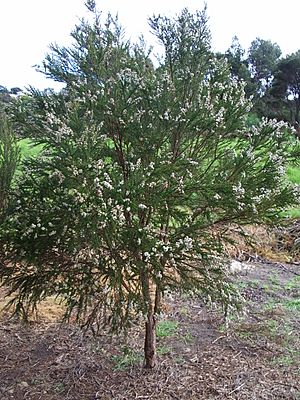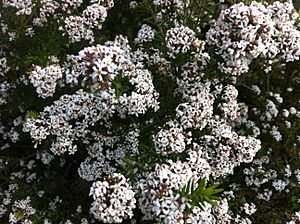Wattie facts for kids
Quick facts for kids Wattie |
|
|---|---|
 |
|
| Scientific classification | |
| Genus: |
Taxandria
|
| Species: |
juniperina
|
| Synonyms | |
|
Agonis juniperina |
|
Taxandria juniperina is a special type of tree or shrub. People know it by many names, like wattie, native cedar, Warren River cedar, or juniper myrtle. This plant grows naturally in the southwest part of Western Australia.
It used to be called Agonis juniperina. But now, scientists have moved it to a new group of plants called Taxandria. The Noongar people, who are the traditional owners of the land, call this tree watti.
Contents
What Does This Plant Look Like?
Taxandria juniperina can grow in different ways. It often grows as a straight, tall tree or a thick shrub. Most of the time, it is less than 10 metres (33 feet) tall. But in its natural home, it can grow much taller, up to 27 metres (89 feet)!
This plant has brown, stringy bark. If you look underneath, the bark is a light red color. When it grows in an open area, it forms a thick bush. But if it's part of a group of trees, it grows tall and straight.
If you gently crush its leaves or young stems, you'll notice a spicy smell. This smell helps us know it belongs to the Myrtaceae plant family. It is also closely related to the Leptospermum plant, which is often called Tea Tree.
The tree has evergreen leaves, meaning they stay green all year. The leaves are very thin and narrow. They are usually about 7 to 13 millimetres (0.28 to 0.51 inches) long and less than 2 millimetres (0.08 inches) wide.
The flowers of Taxandria juniperina appear between February and November. They grow in upright, whitish spikes. Each flower is white, sometimes with a little pink, and about 5 millimetres (0.2 inches) across.
Scientists can tell this plant apart from others in its group. They look at how it grows as a tree and its leaves. The leaves are typically 7 to 13 mm long. They are usually flat or slightly curved upwards. Also, its sepals (parts of the flower) are smooth.
Where Does It Grow?
You can find Taxandria juniperina along the coast in the southwest part of Western Australia. It grows from Busselton in the north, down to Augusta, and then east to Waychinicup National Park, near Albany.
This tree likes to grow near swamps that are wet in winter. It also likes areas near permanent watercourses, which are like small rivers or streams. It can grow in many different kinds of soil. This includes rich loam, soft peat, sand, and even gravel.
Its Scientific Name and History
The first time this plant was officially described was in 1844. A botanist named Johannes Conrad Schauer wrote about it. This was part of a larger work by Johann Georg Christian Lehmann called Plantae Preissianae.
Later, in 2007, two scientists, Wheeler and Marchant, studied the plant again. They decided to move it to a new group of plants. That's when it was officially renamed Taxandria juniperina and placed in the new genus Taxandria.
See also
 In Spanish: Taxandria juniperina para niños
In Spanish: Taxandria juniperina para niños


